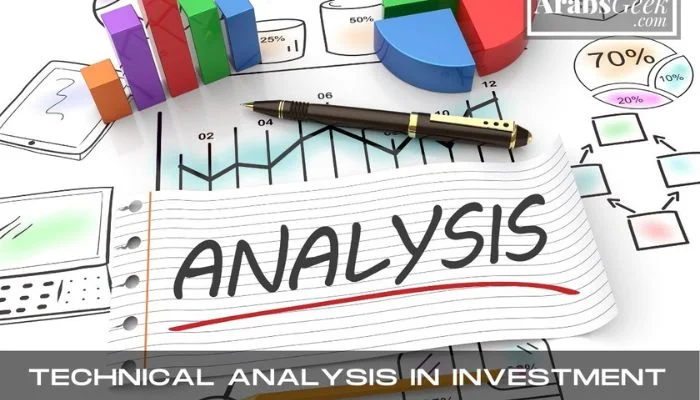Introduction | Technical Analysis In Investment
Definition of Technical Analysis
Technical analysis is a method used by investors to predict future market movements by studying historical price data and patterns. This approach assumes that all relevant information is already reflected in the price, and that past price behavior can be used to forecast future trends.
Table of Contents
Fundamental Analysis vs. Technical Analysis In Investment
Fundamental analysis focuses on evaluating the intrinsic value of a security based on its underlying financial and economic factors, such as earnings, revenues, and market conditions. Technical analysis, on the other hand, relies solely on historical price data and patterns to make investment decisions.
For any business enquiry, you can contact us at ArabsGeek.com
For more of such financial articles, Consider visiting our sister website at EntrepreneursPilot.com
Basic Concepts of Technical Analysis In Investment
Price Action
Price action refers to the movement of an asset’s price over time, as represented on a chart. Technical analysts examine price action to identify patterns and trends that can help them make informed investment decisions.
Support and Resistance
Support and resistance levels are horizontal price levels at which an asset’s price has historically had difficulty moving beyond. Support levels act as a price floor, while resistance levels act as a price ceiling. Technical analysts use these levels to predict potential price reversals and establish entry or exit points.
Trendlines | Technical Analysis In Investment
Trendlines are diagonal lines drawn on a price chart to connect significant price points, such as highs or lows. They help to identify the direction of a trend, whether it’s upward (bullish), downward (bearish), or sideways (range-bound).
Moving Averages
Moving averages are calculations used to smooth out price data and identify trends over a specified period. The two most common types are simple moving averages (SMA) and exponential moving averages (EMA). SMAs give equal weight to each data point, while EMAs give more weight to recent data, making them more responsive to current price action.
Volume
Volume represents the number of shares or contracts traded in a security during a given period. Analyzing volume can help investors gauge the strength of a price movement and identify potential reversals or breakouts.
Technical Indicators | Technical Analysis In Investment
Momentum Indicators
Momentum indicators measure the rate of change in an asset’s price, helping investors determine the strength of a trend and identify potential entry or exit points.
Relative Strength Index (RSI)
RSI is a popular momentum indicator that compares the magnitude of recent gains to recent losses to determine if an asset is overbought or oversold. RSI values range from 0 to 100, with levels above 70 indicating overbought conditions and levels below 30 indicating oversold conditions.
Moving Average Convergence Divergence (MACD)
MACD is a momentum indicator that calculates the difference between two moving averages, typically a 12-day EMA and a 26-day EMA. When the MACD line crosses above the signal line, it generates a bullish signal, and when it crosses below the signal line, it generates a bearish signal.
Oscillators | Technical Analysis In Investment
Oscillators are technical indicators that fluctuate within a defined range, usually around a central value. They help investors identify overbought or oversold conditions and potential price reversals.
Stochastic Oscillator
The stochastic oscillator is a momentum indicator that compares the closing price of an asset to its price range over a given period. It generates overbought and oversold signals similar to the RSI, with values above 80 indicating overbought conditions and values below 20 indicating oversold conditions.
Rate of Change (ROC)
ROC measures the percentage change in an asset’s price over a specific period. It helps investors identify the strength of a price movement and potential trend reversals.
Volatility Indicators | Technical Analysis In Investment
Volatility indicators measure the degree of price fluctuations in an asset over a given period, providing insights into market sentiment and potential trend changes.
Bollinger Bands
Bollinger Bands are volatility bands placed above and below a moving average, typically a 20-day SMA. When the bands widen, it indicates increased volatility, and when they narrow, it indicates decreased volatility. Prices often revert to the mean after touching the bands, providing potential entry or exit points.
Average True Range (ATR)
ATR is a volatility indicator that measures the average range between an asset’s high and low prices over a specified period. A high ATR indicates increased volatility, while a low ATR indicates decreased volatility.
Trend Indicators
Trend indicators help investors identify and confirm the direction of a trend.
Ichimoku Cloud
The Ichimoku Cloud is a comprehensive trend indicator that combines multiple moving averages and other components to provide a holistic view of an asset’s trend, support, and resistance levels.
Directional Movement Index (DMI)
DMI is a trend indicator that measures the strength and direction of a trend by comparing successive price highs and lows. It consists of the +DI, -DI, and ADX lines, which help investors determine if a trend is bullish, bearish, or non-trending.
Chart Patterns | Technical Analysis In Investment
Reversal Patterns
Reversal patterns indicate a potential change in the direction of a trend.
Head and Shoulders
The head and shoulders pattern is a bearish reversal pattern that consists of three peaks, with the middle peak (the head) being the highest and the two outer peaks (the shoulders) being lower.
Double Tops and Bottoms | Technical Analysis In Investment
Double tops and bottoms are reversal patterns that signal a potential change in the trend direction. A double top forms when an asset’s price reaches a resistance level twice before reversing, indicating a bearish reversal. A double bottom forms when an asset’s price reaches a support level twice before reversing, indicating a bullish reversal.
Continuation Patterns
Continuation patterns signal that a trend is likely to continue after a period of consolidation or correction.
Triangles | Technical Analysis In Investment
Triangles are continuation patterns that form when an asset’s price consolidates within converging trendlines. There are three types of triangles: ascending, descending, and symmetrical. The breakout direction of the triangle often indicates the direction of the trend continuation.
Flags and Pennants
Flags and pennants are short-term continuation patterns that form after a strong price movement. Flags are small rectangular patterns that slope against the prevailing trend, while pennants are small symmetrical triangles. Both patterns indicate that the trend is likely to continue once the consolidation period is over.
Timeframes in Technical Analysis In Investment
Technical analysts use different timeframes to study price action and patterns, ranging from intraday (minutes or hours) to long-term (weeks, months, or years). The choice of timeframe depends on an investor’s trading style and objectives, with shorter timeframes being more suitable for day traders and longer timeframes for position traders or investors.
Risks and Limitations of Technical Analysis
Technical analysis is not foolproof, and there are several risks and limitations to consider:
- Subjectivity: Different analysts may interpret patterns and indicators differently, leading to varying conclusions and predictions.
- Self-fulfilling prophecy: Technical analysis can sometimes become a self-fulfilling prophecy, as a large number of traders acting on the same signals can influence price movements.
- Limited predictive power: Technical analysis can’t predict unforeseen events or fundamental shifts that can significantly impact an asset’s price.
- Lagging nature: Many technical indicators are lagging, meaning they reflect past price movements rather than predicting future trends.
Combining Technical Analysis with Other Strategies
While technical analysis can be a valuable tool for investors, it’s essential to combine it with other strategies, such as fundamental analysis, to gain a comprehensive understanding of an asset’s potential. This approach can help investors make more informed decisions and manage their risks more effectively.
Using Technical Analysis for Different Asset Classes
Technical analysis can be applied to various asset classes, including stocks, bonds, commodities, and cryptocurrencies. However, it’s crucial to understand the unique characteristics and market dynamics of each asset class when applying technical analysis tools and techniques.
Conclusion | Technical Analysis In Investment
Technical analysis is a popular investment approach that relies on historical price data and patterns to predict future market movements. By understanding the basic concepts, indicators, and patterns of technical analysis, investors can make more informed decisions and improve their trading strategies. However, it’s essential to consider the risks and limitations of technical analysis and combine it with other investment strategies for a comprehensive approach.
Frequently Asked Questions (FAQs)
Q1: What is the main difference between technical analysis and fundamental analysis?
Fundamental analysis focuses on evaluating the intrinsic value of an asset based on its underlying financial and economic factors, while technical analysis relies on historical price data and patterns to make investment decisions.
Q2: Can technical analysis be applied to all asset classes?
Yes, technical analysis can be applied to various asset classes, including stocks, bonds, commodities, and cryptocurrencies. However, it’s essential to consider the unique characteristics and market dynamics of each asset class when applying technical analysis tools and techniques.
Q3: Is technical analysis always accurate in predicting future market movements?
No, technical analysis is not always accurate in predicting future market movements. It has limitations and risks, such as subjectivity, self-fulfilling prophecies, and the impact of unforeseen events. Combining technical analysis with other strategies like fundamental analysis can help improve the accuracy of predictions and mitigate risks.
Q4: What are some popular technical indicators used by investors?
Some popular technical indicators include Relative Strength Index (RSI), Moving Average Convergence Divergence (MACD), Bollinger Bands, Stochastic Oscillator, and Ichimoku Cloud. These indicators help investors identify trends, momentum, volatility, and potential entry or exit points.
Q5: How do I choose the right timeframe for technical analysis?
The choice of timeframe depends on your trading style and objectives. Shorter timeframes, such as minutes or hours, are more suitable for day traders, while longer timeframes, such as weeks, months, or years, are more appropriate for position traders or long-term investors. It’s essential to experiment with different timeframes and find the one that best suits your trading strategy and goals.











